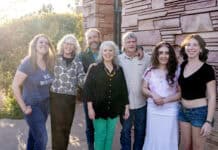Stop and smell the roses, Denise Gould suggests. And while at it, why not stop and smell the herbs, onions and apricots?
Larson Newspapers
________________
Stop and smell the roses, Denise Gould suggests. And while at it, why not stop and smell the herbs, onions and apricots?
Wednesday, Jan. 31, Gould sat in a roundtable discussion with Diane Scantlebury, Dennis Coon, Barbara Garnier and Sandy Boyce. The group met at Boyce’s West Sedona home to brainstorm the next steps in establishing the first community supported agriculture in the Verde Valley.
According to Scantlebury, owner of Tickaboo Farms in Camp Verde, the concept behind what they call Verde Valley CSA is to develop a sense of community between local growers and local consumers.
“The whole idea is that we’re growing locally and selling locally,” says Gould, owner of Camp Verde’s Willowbrook Farm.
Scantlebury says that an additional intention is to build support for farmers who don’t use genetically modified seeds or synthetic pesticides. In turn, that support builds more environmental stewards.
According to the U.S. Department of Agriculture’s National Agricultural Library, Community Supported Agriculture “consists of a community of individuals who pledge support to a farm operation so that the farmland becomes, either legally or spiritually, the community’s farm, with growers and consumers providing mutual support and sharing the risks and benefits of food production.”
The USDA’s introduction further states, “members or ‘shareholders’ of the farm or garden pledge in advance to cover the anticipated costs of the farm operation and farmer’s salary. In return, they receive shares in the farm’s bounty throughout the growing season.”
Boyce, the organization’s coordinator, is busy working to obtain nonprofit designation for the Verde Valley CSA. Although she isn’t a farmer, she’s passionate about its cause.
“I heard about CSAs through the grapevine, no pun intended,” Boyce says.
“There’s approximately 1,700 [CSAs] nationwide. Rolling Prairie Farmers Alliance in Kansas has 300 subscribers,” she adds.
Boyce says she grew up watching her mother follow the advocacy of Adelle Davis, a pioneer in the field of nutrition.
Davis warned people about the dangers of food additives and at the same time promoted whole unprocessed foods. That knowledge and interest simply passed on to another generation, Boyce says.
Garnier, the group’s media director and secretary, takes notes beside flyers, brochures and the “2007 Share Holder Contract” she created for distribution.
She’s recently become familiar with CSA and has even begun growing her own garden in her back yard. She’s anxious to harvest bell peppers, she says.
There are endless reasons the Verde Valley needs a CSA, Boyce says.
“People get fresh produce, and they support their local growers … they work their tails off,” she says.
“It promotes community networking,” Gould says.
“Organic farming is great, but when it’s being trucked in from 800 miles away, it kind of defeats the purpose,” Scantlebury adds.
The Verde Valley CSA originally formed over a conversation between Gould, Scantlebury and Boyce.
The three stood amid last summer’s stock of fruits and vegetables in Camp Verde’s farmers market when they realized how much they had in common.
Boyce went regularly to buy goods at the farmers market in Flagstaff for two years. Gould and Scantlebury, who are neighbors, went also, only to sell their goods.
“The drive became too much. It was just too far,” Boyce admits.
Gould and Scantlebury agree, though they had a different reason to try something new.
“It’s a great market in Flagstaff, but all the growers are from the Verde Valley. Why not have a CSA here?” Gould says.
In the end, rather, the beginning, three minds came together and spawned the idea for the VVCSA.
Dennis Coon, of Coon Family Farms in Cottonwood, was another grower recruited, as were his uncle and aunt, Lee and Elberta Hulsey.
Coon’s family originally arrived in the Verde Valley in 1924. They started ranching in 1925 on a property near Clarkdale.
Coon’s ranch sat beside what was once known as Jordan Orchards, owned by Will Jordan. Unfortunately, smoke from smelters damaged trees and Jordan moved to Sedona.
“Now, there’s nothing but a slag pile there,” Coon says.
The plan is to sell 30 shares of the VVCSA at a cost of $520 each. Each share is an entitlement to participate in the 26-week season that lasts from Wednesday, April 25, to Wednesday, Oct. 17.
During the season, the CSA will meet each Wednesday between 3 p.m. and 6 p.m. at Cornville’s Windmill Park to distribute crops. “Shareholders” arrive to pick up these weekly bags of produce valued at a minimum of $20.
Scantlebury says they want to focus on simplicity this year.
“We’ll have the basic staples, although they’ll get sexier with colored bell peppers and such, as the season moves along. But, as I said, we’re going to be working really hard to put $20 worth of produce in 30 bags and make 30 people really happy, ” she says, smiling.
According to Boyce, there are currently 16 shareholders. They anticipate selling the remaining 14 shares shortly.
After reviewing the definition of CSAs several times, VVCSA members are confident it will be successful. If anything, it’s necessary.
“Diane [Scantlebury] has a greenhouse, so she grows year-round. Denise [Gould] is building a greenhouse. I think we’ll have everything covered, regardless of weather and risk,” Boyce says.
When questioned about the price, she reminds people of what groceries cost at New Frontiers Natural Marketplace and other specialty food stores.
“It’s easy to spend $40 there,” she says.
Gould reflects on Coon’s family ranch in 1925. She thinks of the orchards that once flourished in Sedona and the Verde Valley.
“I think it’s great that these ranches existed in the early 1900s, and now they’re coming back around. It’s almost full- circle,” Gould says.



















